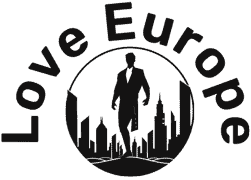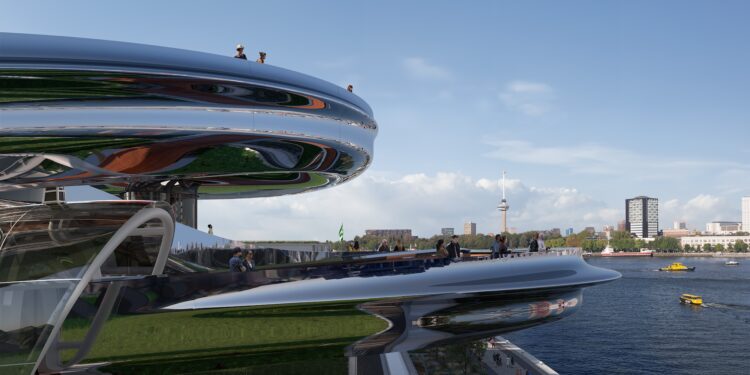Also announced today is the opening in the second half of 2025 of the new home of National Museum of Photography. It is moving from its existing site to the Grade A listed, eight floor, cast iron columned Santos building thanks to a donation by Droom en Daad. A beautifully restored landmark in the heart of the city, the historic building opened in 1903 as a warehouse for storing Brazilian coffee.
The new expanded spaces will deliver unprecedented access to the work of restoring and documenting the collection, as well as world-class displays of Dutch photography of all periods. The collection now numbers some six million items, making it one of the largest museum collections of photography in the world.
Alongside these two developments, revealed today is an ambitious plan to develop Danshuis, a new state of the art international dance centre for hip hop, tango and folk dance as well as classical ballet on a site next to Fenix in a design by MAD Architects. Work will begin in 2025 towards an opening in 2030 to provide world class performance spaces, as well as spaces for community development of dance, open to all.
Wim Pijbes, Director of Droom en Daad, said today:
“We believe that the transformation of Rotterdam, building on its history as an open and vital centre for international trade as well as a port city renowned for its contemporary architecture from De Stijl to Rem Koolhaas, will see it as the defining European city of cultural development in the 2020s – a new home to new institutions in Europe’s most forward-thinking city.”
About Rotterdam and Droom en Daad Foundation
Built on the foundation of its world-leading architecture, Rotterdam is set to become the defining European city of cultural development in the 2020s.
Rotterdam has long been a city of trade and merchants – a port city defined by what were until as recently as 2004 the world’s largest docks.
In 1918 the Great War ended, the Spanish flu was under control, a new era had started raising the curtain on the ‘Roaring 20s’. Rotterdam went through a unique, thriving period of unparalleled ambition and zest for building. The optimistic sound of the Jazz Age was everywhere, women were given the right to vote and there was now radio and film. Rotterdam was very well connected with New York: Louis Armstrong made his European debut, Josephine Baker performed in Rotterdam.
World War II created a city that needed to build again. On the night of 14 May 1940, The Rotterdam Blitz, in just 15 minutes, flattened the city and made 80,000 people homeless in a single night. Just four days later in the face of military occupation, the city of Rotterdam commissioned the architect Willem Gerrit Witteveen to develop a new city plan. Since then, Rotterdam has been a city in a constant act of being rebuilt.
In the 1990s and early 21st century, with the docks in industrial decline, that rebuilding began to focus on the city’s waterfront areas. Amongst other developments seven new large scale city parks were commissioned. Rijnhavenpark, developed by Michael Van Valkenburgh Associates, will turn three sides of the harbour on which Fenix and the Santos Building sit into a new waterfront landscape.
In 2001 Rotterdam was named European City of Culture, and this began a journey which has seen the city’s radical innovative spirit fully extended to its cultural institutions. The Museum Boijmans Van Beuningen, currently under redevelopment, is one indication of that radicalism. With its superb collection of masterworks by Rembrandt, Van Gogh, Rubens, Dali, Bosch and Monet, the Boijmans has changed the approach of museums around the world. The Depot Boijmans Van Beuningen, opened in 2021, is the world’s first fully accessible art storage facility, which has spawned a generation of subsequent projects around the world.
Since 2016, the Droom en Daad Foundation has worked alongside the municipality of Rotterdam on a major programme of investment. This includes the renovation of het Park, the city’s most beautiful park, and a listed monument, opened in 1852, including the establishment of a Park Foundation for the sustained management of this national monument. Alongside the forthcoming developments of Fenix, the National Museum of Photography and Danshuis and capital support of the Museum Boijmans Van Beuningen, this also includes the creation of Batavierhuis, a makerspace and incubator for musicians in Rotterdam; Veerhuis, a home for writers; Muziekwerf, where everyone between the age of 6 and 26 is welcome to make music together; and in the streets of Rotterdam, a series of public art commissions that most recently includes the installation of Thomas J Price’s monumental bronze sculpture Moments Contained outside Rotterdam’s train station.
CategoriesTagsArchitectureDroom en Daad Foundation
Source link : http://www.bing.com/news/apiclick.aspx?ref=FexRss&aid=&tid=673f292a0047492e903cec4f02b4f900&url=https%3A%2F%2Ffadmagazine.com%2F2024%2F11%2F21%2Frotterdam-looks-to-re-invent-itself-with-major-cultural-investement%2F&c=14272033811302356597&mkt=de-de
Author :
Publish date : 2024-11-21 04:10:00
Copyright for syndicated content belongs to the linked Source.




